It’s clear that we need to build more resilient soils, both for the future of our farms and for the long-term health of the land. The satellite images of muddy waters spilling out of brown rivers around the UK after a heavy rainfall are hair-raising. We can visibly see the soil gliding off fields, into water streams and off into the sea. At the very least this is quite literally money going down the drain for anyone working from the land, at its worst this is hundreds of years of top-soil formation being lost forever and part of a global disaster. Soil health advisors are quite certain that this scenario is avoidable, it’s all down to how land is managed.
If this is the case then building soil health should be one of the top priorities on every farm. One major difficulty is how do we know if we are building soil health or not at a farm level? Science doesn’t seem to offer a simple answer to this at the moment, which could be considered quite worrying, but we see it another way: This is an opportunity for farmers and growers to lead the way, to become experts on monitoring and building soil health on their own farm.
September and October are the best time to do most of the soil health tests in the UK. So prepare to soak up all the tips and tricks from what we have learned so far, and then get out there learning and observing your own soils in the coming months! This is the first step to becoming an expert on monitoring and building soil health for your soils.
How can Farmers monitor their own soils?
We started working with the PastureFed Livestock Association (PFLA) and Soils Advisor, Niels Corfield, to investigate this very question. The PFLA ran a series of workshops where scientists and farmers came together and identified the most appropriate soil tests, based on all the resources and research available. We took the most popular in-field tests and went out on multiple farms to see how it worked in practice. We didn’t have an easy way of recording the results so we developed a version of our app, Sectormentor for Soils, that allowed us to record the observations and photos as we went for each field.
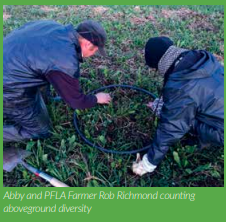
To understand the health of your soils it’s important to see how things are changing over time and examine trends of different indicators. In order to do this we encourage growers to set goals for each field they are monitoring and then choose four to five tests that monitor the results as they change management practices to meet those goals. For example, one PFLA farmer in Kent, Fidelity Weston wanted to see if grazing her animals differently would improve forage and carrying capacity on the land, without compromising diversity. As she changes her practice, she is monitoring the percentage of grasses/broadleaves and sward stick readings above-ground as well as Slake test, infiltration rate and a visual evaluation of the soil below to see how the change affects her goal.
We have found the most effective tests are very physical measures that are immediately understandable. There are lots of different protocols out there for how to do these tests, but we hope to provide a method with a good balance between being do-able for farmers and providing useful insights, as well as being based on sound science. You can find an equipment list, and clear guidelines for doing each test on our website soils.sectormentor. com. Here are three we have found particularly helpful:
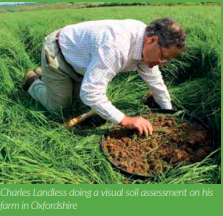
Slake Test (Wet Aggregate Stability)
The Slake test is a simple in field test that allows you to really see how well your soil structure holds up in water. It is also an indicator of biological activity. We have started to work with Soil Health Expert Jenni Dungait (previously soil health Professor at Rothamsted) and have adopted the in-field method she used in her research with farmers on multiple farms in Cornwall and Cotswolds regions.
Well-structured soil is composed of aggregates, so in this slake test you put a few small pieces of soil in a sieve, submerge them in water and then shake them around quite vigorously. Those small pieces that survive without breaking down at all are true aggregates, the water remains totally clear. For non-aggregates there is considerable break down of the pieces and the water can become murky. You score the breakdown on a scale of zero to eight, eight indicates a soil full of microbes and made up almost exclusively of aggregates. All details here An additional benefit of this test was highlighted by Jenni Dungait’s research (soon to be published) which shows that the slake test is an excellent proxy for Soil Organic Carbon.
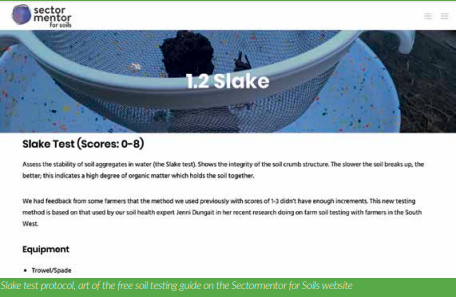
Earthworms
All growers inherently understand the value of earthworms as we see them physically move nutrients around the soil profile. Earthworms are one of the larger organisms in the soil food web, so many earthworms is a good indicator of plenty of life in your soil.

In the UK, an average of 15-20 worms in a 20x20cm soil pit is considered good. Earthworms counts are best done in late September to early October. This year we are preparing to do slightly more detailed earthworm counts based on the work of soil scientist Jackie Stroud at Rothamsted. There are three main types of earthworm: the litter-feeders which break down organic matter on the surface of the soil; the top-soil worms who work on soil aggregation and nutrient mobilisation; and then the deep-burrowers that keep water flowing from the soil surface to deep pools below, as well as increasing aeration and root development.
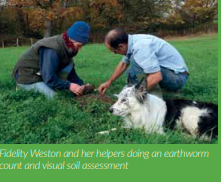
Jackie’s research shows that if you identify numbers of each type of worm, it can tell you what the worms are working on and uncover any changes you might need to make in your soil management to encourage all types – ideally you want to have all three types of worm working in harmony. Jackie Stroud is running a #30minworms citizen science project in September where she is asking farmers all around the country to dig 5 pits in a field and do earthworm counts and send her the results. You can find out more in the earthworm test protocol on our site, where you will also find a link to Jackie’s Worm ID Quiz, which is a brilliant way to learn how to identify types of worm for yourself.

Infiltration rate
The Infiltration rate test clearly shows how ready your soil is to soak up water when it comes. To do this test we use a 150mm diameter pipe (actually part of a chimney flue) and hammer the pipe 75mm into the ground. Then we pour in a set amount of water and time how long it takes the water to infiltrate. Originally we used a much smaller diameter baked bean tin to do the infiltration tests but we were finding it took over 20 minutes for the water to infiltrate which made it impractical to do in the field. One thought was forcing such a small diameter cylinder into the ground was causing artificial compaction in itself, which is why we have moved to a larger diameter cylinder.
Our aim is to find a method that takes a maximum of five minutes in most soils. This test is so relevant, imagine if every farmer and grower around the land had a clear idea of the average infiltration rate in each of their fields. We would definitely be better equipped to prevent those muddy rivers and top-soil losses.

The value of the app – soil health trends and patterns on your own farm. You can use all three of these tests, combined with above-ground observations to build up a picture of the health of your soil in each field, and see how it changes over time. This is how you start to become a soil health expert on your farm, go out and look for yourself, observe, document, ask questions and build up a picture over time.
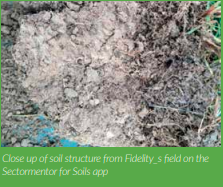
The Sectormentor for Soils app makes it easy to record these observations in the field as you go, and then turn those observations into graphs and insights. Just a few taps and you have everything recorded, alongside photos showing what you saw both above and belowground. Essentially you can build up a visual diary for each field combined with numerical results from the tests. All those results are easily searchable (no more shuffling through piles of papers to try and find those scribbled notes) and quickly show how your soil health is changing over time.
Shared Perspectives and Added Learning
One other important piece of the puzzle for many farmers and growers is the power of discussion and other people’s perspectives. When you are out in the field taking these observations, in order to become an expert and understand better what’s happening we have found that it’s important to share your observations with others and get other perspectives. This is a big part of the learning.
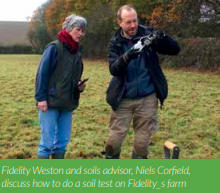
Where possible it’s great if you can go out in a group, or with your agronomist. The digital diary on the app is perfect for this as it’s easy to share photos and results with other farmers, or to discuss things you have seen with an agronomist. That is a summary of our learnings for now. We are excited to support many more farmers and growers to get out there and become confident monitoring their own soils, head to our website soils.sectormentor.com where you will find more info about the app, our free online guide to the different soil tests and a blog filled with resources, case studies from different farmers and more. This is a brilliant opportunity for farmers and growers to move from here-say and anecdotes about what works on their farm into a more structured evidence base, not scientifically rigorous data, but just what is needed to build up the patterns and stories on your farm. This is about becoming a soil health expert for your farm.